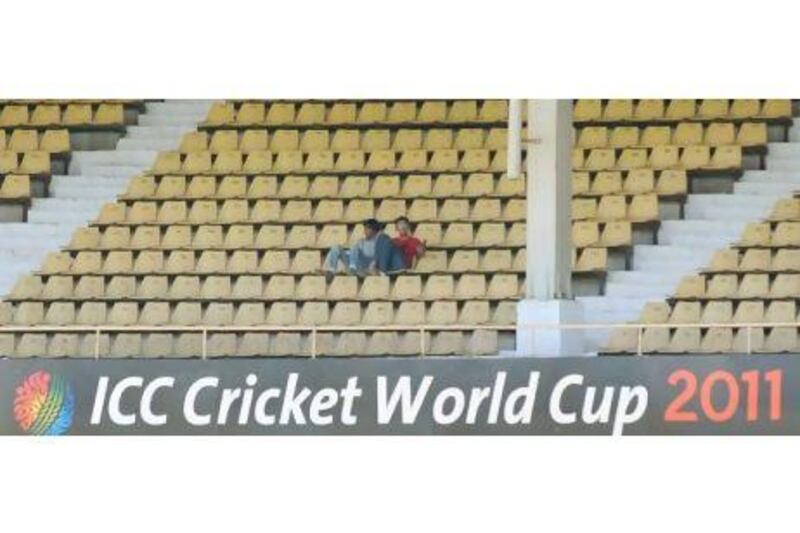It has become the laziest cliche of all, how cricket is religion on the subcontinent. Try telling that to Pakistan and Kenya players who played in front of empty stands at Hambantota, or England and the Netherlands who had an audience of bussed-in schoolchildren for their World Cup opener.
There was indeed a time when an international match meant packed galleries and an electric atmosphere.
These days, though, with so much cricket played and far more entertainment options, the passionate support is reserved for when the home team plays. When matches feature minnows, most people do not want to know, ask those brave few who turned up to see reigning champions Australia crush Canada in Ahmedabad on Monday.
This is being written from the Feroz Shah Kotla, in New Delhi, where the West Indies, two-time champions now fallen on hard times, are taking on South Africa, one of the pre-tournament favourites. Just over 10,000 people have turned up, and entire sections of the stands lie empty.
Imagine Argentina taking on Spain at the football World Cup. No matter where the game was played, you would struggle to find a spare seat. For now, cricket is failing the audience test. Emphatically.
Not that all subcontinent fans should be grouped together. They were magnificent in Bangladesh, with as many people milling around outside the stadium as there were inside for both the opening ceremony at the Bangabandhu and the match against India in Mirpur.
A friend who went to watch the warm-up game between England and Pakistan at Fatullah spoke of 15,000 crammed into the ground. Wherever you went, people wanted to talk to you about cricket and their hopes for their beloved team.
Sri Lanka seems to share India's apathy for the event, except when the home team are playing. Trevor Chesterfield, a veteran journalist who covered the Pakistan game in Hambantota, wrote: "Good venue in the middle of nowhere. I'm an hour from the ground. Some are 90 minutes out. It takes 40 minutes with police escort to get the team here from a three-and-a-half star hotel into the middle of an elephant jungle."
_____________________________________________________________________________________
[ Play the 2011 Cricket World Cup video game now ]
_____________________________________________________________________________________
For the Pakistan game, 10,000 students from 21 local schools were tempted with an offer of free tickets and meals to boost attendance at the 35,000-seat Mahinda Rajapaksa Stadium.
With Sri Lanka not in action though, only 3,000 turned up.
In Nagpur, fans were put off not just by the prospect of a one-sided match, but also by the distance of the venue from the city. With public transport non-existent and a rickshaw ride costing as much as 200 Rupees (Dh16), few bothered. The International Cricket Council (ICC) had arranged buses for journalists. For the fans? Nothing.
As for Delhi, only a masochist would bother to turn up, given the notorious Delhi Police and the incompetence of the local association. The match tickets given to us did not work at the turnstiles, and what passes for security frisking here would be called harassment in most countries. Such quibbles aside, there are few tickets on offer for the average fan anyway.
It makes you wonder why the tournament is being held in the first place. Is it for the benefit of the thousands of freeloaders, or for the game's most important constituents, the fans? The ticket allocations appear to suggest that the fan is the last priority.
Earlier yesterday, police baton-charged fans queuing up for tickets outside the Chinnaswamy Stadium in Bangalore. With so many tickets allocated to sponsors, advertisers and whoever else has an influence with the local association or the ICC, the genuine fans are lucky to have a couple of thousand seats to go at.
The other objects of official derision are the Associate teams, enjoying what is likely to be their final World Cup. The ICC has already announced plans for a 10-team World Cup in 2015, with qualifying criteria likely to make it extremely difficult for Associate teams to be a part of the event.
Ryan ten Doeschate's superb all-round performance for the Netherlands in Nagpur so nearly embarrassed those who prefer cricket to remain a cliquey sport. Instead of encouraging the likes of Ireland and Afghanistan, every effort is being made to slam the door.
It does not take a rocket scientist to figure out why. Since the game sold its soul to television, it has become imperative that India - home to the vast majority of sponsors and advertisers - play as many games as possible. The format has to ensure Indian participation in the final stages.
An early exit, as in the Caribbean in 2007, spells commercial doom.
Anyone with an iota of sense could tell you that it is possible to keep both sides happy. Have 20 teams, and four groups of five. That way, a freak result or upset would not send a fancied team home. If an Associate nation was to reach the knockout stages, they would have to do it the hard way. Sadly, they are unlikely to be given that chance.





